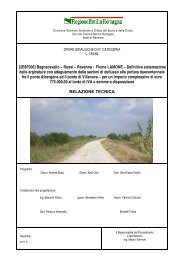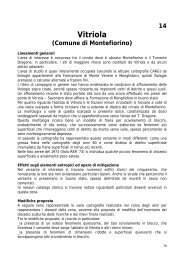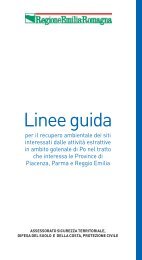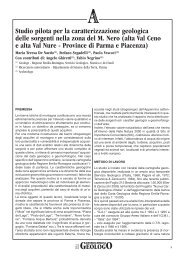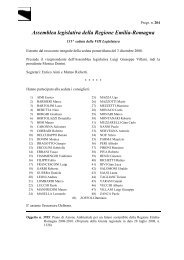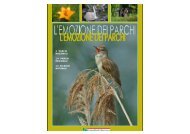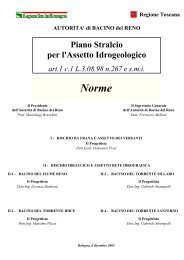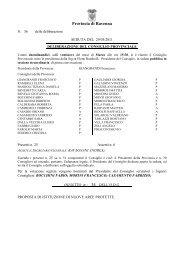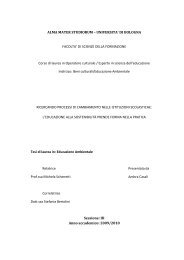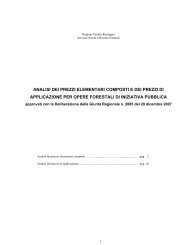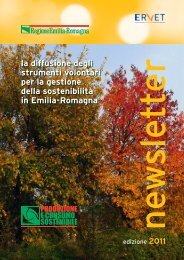air, water and soil quality qualité - ER Ambiente - Regione Emilia ...
air, water and soil quality qualité - ER Ambiente - Regione Emilia ...
air, water and soil quality qualité - ER Ambiente - Regione Emilia ...
Create successful ePaper yourself
Turn your PDF publications into a flip-book with our unique Google optimized e-Paper software.
lected from some profiles excavated in a urban garden located in the city centre, in<br />
a agricultural field just north of the city. In addition, several profiles were "opened"<br />
<strong>and</strong> subsampled in the San Vitale Pinewood, a protected area close to a large industrial<br />
complex.<br />
Among all the investgated profiles, six of them were selected to compar total<br />
(XRF) <strong>and</strong> pseudo-total (aqua regia) (Alloway, 1990) metal concentrations. Total<br />
element concentrations are more relevant if a geochemical interpretation of data is<br />
requited as in this specific study. Besides, direct comparison with available geochemical<br />
data on sedimentary deposits in the area is also possible. Following the<br />
pseudo-total approach, result describe the maximum concentration of an PTE that<br />
can be released from a parent materials in natural environment. The aqua regia<br />
leach or digestion procedure is normally used for simulating this characteristic in<br />
the laboratory. It is potentially extremely interesting, althoug it can be affected by<br />
many uncertainties regarding the operating procedures. In any case, the comparison<br />
of the two results ìs a useful approach to discuss <strong>and</strong> to gain an insight into metal<br />
stability in the <strong>soil</strong> environment.<br />
Materials <strong>and</strong> methods<br />
Sites description <strong>and</strong> <strong>soil</strong> profiles sampling. The study area belongs to the Ravenna<br />
Municipality (<strong>Emilia</strong> Romagna region), a complex territorial system<br />
chatacterized by the development of petrolchemical industrial complex <strong>and</strong>,, also,<br />
by an intensive agricultural activity. The monitoring sites selected in Ravenna city<br />
were: the Central Urban Park (GP) located in the historical city, the ITAS “L. Perdisa”<br />
extra-urban farm (P<strong>ER</strong>), <strong>and</strong> the San Vitale Pinewood (PW), an importance<br />
community site (ICS).<br />
Geographical location. Three zones of different anthropogenic impact were identified:<br />
the San Vitale Pinewood probably affected by atmospheric deposition that<br />
could be derived from the petrolchemical industry or from vehicle exhaust (<strong>soil</strong><br />
profiles PW1, PW4, PW6, <strong>and</strong> PW8); a public garden within Ravenna city, mainly<br />
affected by traffic pollution (<strong>soil</strong> profile GP1); the farm "Luigi Perdisa" located<br />
immediately northwards of Ravenna was selected because of the use of fertilizers<br />
<strong>and</strong> also subject to various types of atmospheric deposition (<strong>soil</strong> profile P<strong>ER</strong>2). All<br />
the sites were georeferenced (UTM33-WGS’84 reference systems) using a GPS<br />
system (Fig.1).<br />
Pedological survey. The San Vitale Pinewood is located along the 118 pedological<br />
delineation of the <strong>Emilia</strong> Romagna region (www.regione.emilia-romagna.it).<br />
C<strong>ER</strong>3/SAV1/PIR1 <strong>soil</strong>s were present. The San Vitale Pinewood is characterized<br />
by s<strong>and</strong> <strong>and</strong> calcareous <strong>soil</strong>s forming upon deposits of s<strong>and</strong> bar consolidated by old<br />
reforestation. Cerba (C<strong>ER</strong>3), <strong>and</strong> Aquic Ustipsamments (USDA, 2006) are the<br />
most commonly represented <strong>soil</strong>s; in those areas which are morphologically higher,<br />
San Vitale <strong>soil</strong>s, Typic Ustipsamments (SAV1) are present whereas in those lower<br />
areas, between the dunes, Pirottolo <strong>soil</strong>s are recognized (PIR1,Typic Psamma-<br />
132



